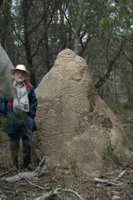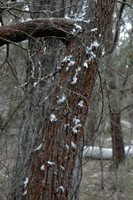 Today, Roy Freere and I visited a private property in the mixed Eucalypt forests of Canyonleigh. We went in search of rare and unusual species of plants, birds and fungi. We had a nice time in the bush, with our hosts.
Today, Roy Freere and I visited a private property in the mixed Eucalypt forests of Canyonleigh. We went in search of rare and unusual species of plants, birds and fungi. We had a nice time in the bush, with our hosts.
The sandstone plateau was covered in dense regrowth of Stringybark, Scribbly Gums and Grey Gums, for the property has been logged for firewood. As you can see from the attached photo, there were some very fine examples of termite mounds.
There was a very interesting gully, with a permanent stream, fed by springs coming out of rock ledges, about 20 metres below the top of the plateau. This gully had some caves with interesting eroded rock features.
 The ledge below the cliff had exposed oil shale or perhaps very low grade coal, in shallow strata. There was a wet point, where rust-stained water oozed out from below a rock ledge. There were several Fungi growing in the red-brown mud there.
The ledge below the cliff had exposed oil shale or perhaps very low grade coal, in shallow strata. There was a wet point, where rust-stained water oozed out from below a rock ledge. There were several Fungi growing in the red-brown mud there.
There were also several tiny, dark brown froglets there, little more than the size of a fingernail.
We had lunch at a point overlooking the Wingecarribee River (or a tributary). Although we were in sandstone country, the edges of this valley were steep, but not cliff-faced, unlike the more familiar escarpments of the local coastal escarpment, or the edges of the Kangaroo Valley.
My favourite observation was a tree dotted with white fluffy feathers, (see above, left) which indicated that a Wonga Pigeon had been killed by a large bird of prey, most likely a large Owl, possibly even a Powerful Owl.
 We also found several specimens of the Ground Orchid known as Parson's Bands (Eriochilus cucullatus). It is a tiny pink-white Orchid, which flowers in late summer and autumn, and has a preference for sandstone-based soils apparently.
We also found several specimens of the Ground Orchid known as Parson's Bands (Eriochilus cucullatus). It is a tiny pink-white Orchid, which flowers in late summer and autumn, and has a preference for sandstone-based soils apparently.
There were also many other interesting plants in the "myrtle" family, which formed a low mat of heath growth, which were notable for their lemon scent. These plants might have been the Micromyrtus ciliata, but, as they were not in flower, I cannot be sure.

No comments:
Post a Comment